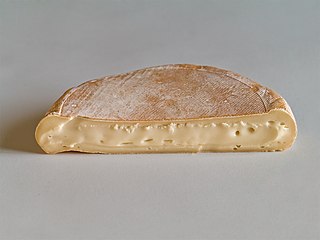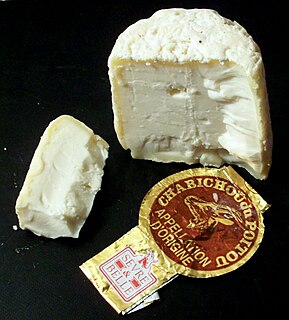
Lasagne are a type of pasta, possibly one of the oldest types, made of very wide, flat sheets. Either term can also refer to an Italian dish made of stacked layers of lasagne alternating with fillings such as ragù, vegetables, cheeses, and seasonings and spices, like Italian seasoning, such as garlic, oregano and basil. The dish may be topped with grated cheese, which becomes melted after baking. Typically, cooked pasta is assembled with the other ingredients and then baked in an oven. The resulting casserole is cut into single-serving square portions.

Brie is a soft cow's-milk cheese named after Brie, the French region from which it originated. It is pale in color with a slight grayish tinge under a rind of white mould. The rind is typically eaten, with its flavor depending largely upon the ingredients used and its manufacturing environment. It is similar to Camembert, which is native to a different region of France.

Goat cheese, or chevre, is cheese made from goat's milk. Goat cheese is made in a wide variety of styles, from soft fresh cheese to hard aged cheese.

Reblochon is a soft washed-rind and smear-ripened French cheese made in the Alpine region of Savoie from raw cow's milk. It has its own AOC designation.

Comté is a French cheese made from unpasteurized cow's milk in the Franche-Comté traditional province of eastern France bordering Switzerland and sharing much of its cuisine. Comté has the highest production of all French Appellation d'origine contrôlée (AOC) cheeses, at around 66,500 tonnes annually. It is classified as a Swiss-type or Alpine cheese.

Saint-Nectaire is a French cheese made in the Auvergne region of central France.

Époisses, also known as Époisses de Bourgogne, is a legally demarcated cheese made in the village of Époisses and its environs, in the département of Côte-d'Or, about halfway between Dijon and Auxerre, in the former duchy of Burgundy, France, from agricultural processes and resources traditionally found in that region.

Sainte-Maure de Touraine is a French cheese produced in the province of Touraine, mainly in the department of Indre-et-Loire. It is named after the small town of Sainte-Maure-de-Touraine, in the department of Indre-et-Loire, at equal distance from westly Chinon and eastly Loches.

Chabichou is a traditional semi-soft, unpasteurized, natural-rind French goat cheese with a firm and creamy texture. Chabichou is formed in a cylindrical shape which is called a "bonde", per the shape of the bunghole of a gun barrel. and is aged for 10 to 20 days. It is the only goat cheese that is soft ripened allowed by Protected Designation of Origin regulations to be produced using pasteurized milk. Chabichou is very white and smooth, and flexible to the palate, with a fine caprine odor.

Uruguayan cuisine is a fusion of cuisines from several European countries, especially from Mediterranean foods from Spain, Italy, Portugal and France. Other influences on the cuisine resulted from immigration from countries such as Germany and Scotland. Uruguayan gastronomy is a result of immigration, rather than local Amerindian cuisine, because the new colonies did not trust the native Charrúa people. Spanish influences are very abundant: desserts like churros, flan, ensaimadas yoo (Catalan sweet bread), and alfajores were all brought from Spain. There are also all kinds of stews known as guisos or estofados, arroces, and fabada. All of the guisos and traditional pucheros (stews) are also of Spanish origin. Uruguayan preparations of fish, such as dried salt cod (bacalao), calamari, and octopus, originate from the Basque and Galician regions, and also Portugal. Due to its strong Italian tradition, all of the famous Italian pasta dishes are present in Uruguay including ravioli, lasagne, tortellini, fettuccine, and the traditional gnocchi. Although the pasta can be served with many sauces, there is one special sauce that was created by Uruguayans. Caruso sauce is a pasta sauce made from double cream, meat, onions, ham and mushrooms. It is very popular with sorrentinos and agnolotti. Additionally, there is Germanic influence in Uruguayan cuisine as well, particularly in sweet dishes. The pastries known as bizcochos are Germanic in origin: croissants, known as medialunas, are the most popular of these, and can be found in two varieties: butter- and lard-based. Also German in origin are the Berlinese known as bolas de fraile, and the rolls called piononos. The facturas were re-christened with local names given the difficult German phonology, and usually Uruguayanized by the addition of a dulce de leche filling. Even dishes like chucrut (sauerkraut) have also made it into mainstream Uruguayan dishes.

Valençay is a cheese made in the province of Berry in central France. Its name is derived from the village of Valençay in the Indre department of the Centre-Val de Loire Region.

Selles-sur-Cher is a French goat-milk cheese made in Centre-Val de Loire, France. Its name is derived from the commune of Selles-sur-Cher, Loir-et-Cher, where it was first made in the 19th century.

Picodon is a goats-milk cheese made in the region around the Rhône in southern France. The name means "spicy" in Occitan.

Fourme de Montbrison is a cow's-milk cheese made in the regions of Rhône-Alpes and Auvergne in southern France. It derives its name from the town of Montbrison in the Loire department.
Cazelle de Saint Affrique is a soft-ripened, pungent cheese, made from pasteurized sheep's milk in the Midi-Pyrénées region of France. It is an artisan cheese, hand-fashioned in small rounds.
Murcian cheese is a fatty goats' milk cheese from the Murcia region of south-east Spain. It has a Protected Designation of Origin. The cheese is made exclusively using goat's milk of the Murcian breed from registered herds which graze freely on scrub and coarse pasture characteristic of that dry geographical zone. The cheese is made in two forms:

The cuisine of Corsica is the traditional cuisine of the island of Corsica. It is mainly based on the products of the island, and due to historical and geographical reasons, has much in common with Italian cuisine, and marginally with those of Nice and Provence.

















